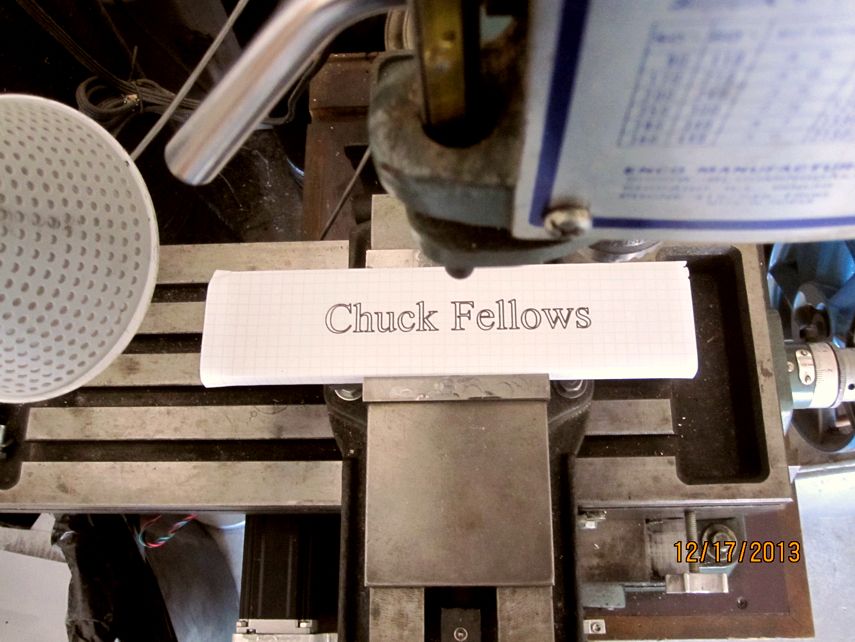Chuck,
I have enjoyed your post on the mill conversion and your many other build posts and projects. I have been contemplating converting my knee mill to cnc. Like you I am not worried about high speed cutting and can always upgrade to bigger motors someday. Did you have a particular plan you followed or web site that was most helpful? I have been browsing and studying for a couple of weeks, there is a lot of info out there, but I haven't found anything like a simple block diagram to follow. Any advice from someone who has been there done that?
Looks like your conversion was a great success.
Thanks for your time and for all of the posts that we have to learn from.
Mike Nay
Thanks for the compliments, Mike, much appreciated. Like you, I did visit a number of websites prior to and during my conversion. None stand out in my memory as being a one-stop-goto reference although Bob Warfield's website,
www.cnccookbook.com has a lot of good information. I also started a build thread on CNC zone and got some good feedback there. Unfortunately, there are a lot of different views out there and it can be difficult to sort out the good information and determine what will be required for your own application.
One of my overriding concerns was not to make any modifications to the mill that couldn't be reversed. I wanted to be able to easily convert it back to its original, manual operation later if needed.
It turns out that the Nema 23, 425 oz in, 3 amp stepper motors were more than adequate for my conversion. They have a pretty high inductance, so won't run as fast as some others, but have plenty of torque. I originally used a 20 tooth timing pulley on the X and Y motors and 60 tooth pulleys on the lead screws but just recently I changed over to 40 tooth pulleys giving me a 1 to 2 ratio. This speeded things up by 50 percent and I still seem to have plenty of torque.
The ball screws I bought were SFU1605 from China. I bought them with unfinished ends to save on cost. Although they are hardened, I was able to machine them in my Logan 11" lathe using (sharp) carbide inserts. Installing the ball screws is the most tedious part. You have to make sure that the ball nut is in perfect alignment with end bearings so they turn freely and there is no binding or bending of the leadscrew. I had to depend on some shimming, using trial and error, to get things in alignment. And, of course, you have to eliminate any end play in the lead screw. I replaced the thrust bearings with angular contact bearings although I'm not sure that was really necessary.
So far I've been very pleased with my results. It's very accurate and, even though I'm extremely conservative on cutting speeds and depths, it's fast enough for me.
If you're like me, you probably are focused on the mechanical aspect of the conversion and haven't thought much about the electronics or software considerations. Those items will wind up costing a lot more than the steppers, ball screws and other mechanical parts. For starters, I decided to use the Gecko G540 stepper controller. At $260 (on ebay) it's pretty expensive but it was well worth it. It's very robust, easy to configure, and seems to be relatively bullet proof. My 24 volt, DC power supply was under $40, but if you decide to go with 48 volts or higher, the cost will be over $100 unless you are a better shopper than I am. And, of course, you'll need a desktop computer with a parallel port if you plan to use Mach 3. I bought a used one for about $75.
That brings us to the software. You mostly need three pieces of software, CAD, CAM, and the G-Code translator and, the biggest problem is, they have talk to each other. That basically means the CAD program has to be able to create a file format that the CAM program can read. And the CAM program must create a G-Code file that the translator can read. And, while there are standards, there are many standards, particularly if you get into full 3D, contour type CNC. I haven't ventured into the murky waters of full 3D and probably won't.
Starting at the end, I bought a Mach3 license for about $160 and have been eminently pleased with it. I still haven't learned all the ins and outs, but it was pretty easy to get up and running. You'll also need a CAD program to do your drawings. I use Visio for all of my 2D drawing and, since it will create DXF files, it works fine for me. That brings us to the CAM software, which is a real bucket of worms. It's by far the most complex part of the CNC equation and potentially the most expensive. I couldn't find any free CAM software that was satisfactory so I settled for CAMBAM. This was $149 and seems to be popular in the hobbyist community. You can download a fully functional copy of it to play with and it's free for the first 40 sessions. It's pretty intuitive and quick to learn the basics, especially for 2.5D CNC. 2.5D CNC means you can do 3D machining, but only 1, two-dimensional surface at a time, although you can string them together end to end as long as they are in the correct order. CamBam will do 3D contouring using 3D printer input files (STL), but will not handle full on 3D CAD files such as IGES or other, more complex 3D file formats.
This may be information you already have but thought it might be interest.
Chuck











































![MeshMagic 3D Free 3D Modeling Software [Download]](https://m.media-amazon.com/images/I/B1U+p8ewjGS._SL500_.png)












![DreamPlan Home Design and Landscaping Software Free for Windows [PC Download]](https://m.media-amazon.com/images/I/51kvZH2dVLL._SL500_.jpg)







